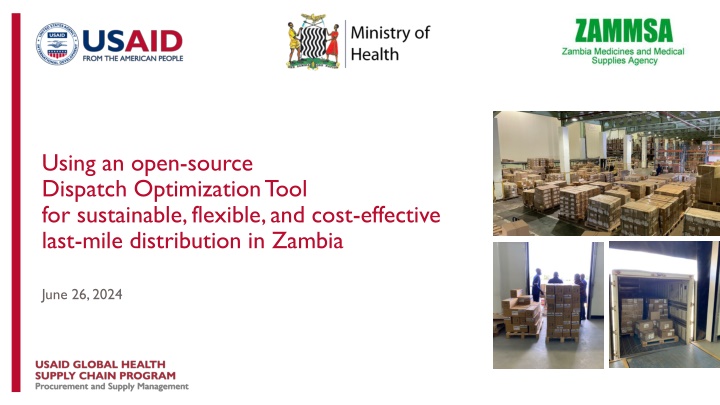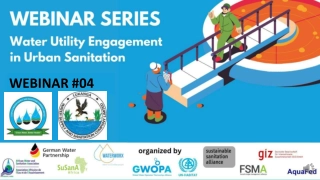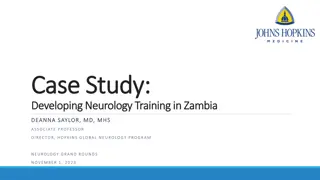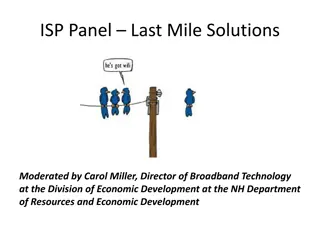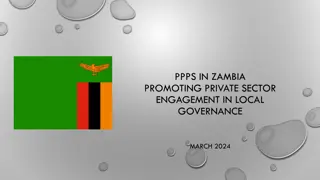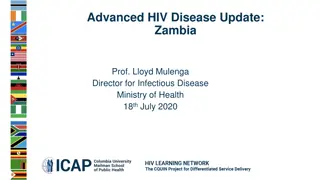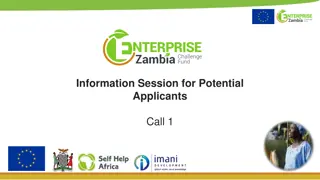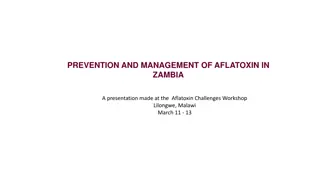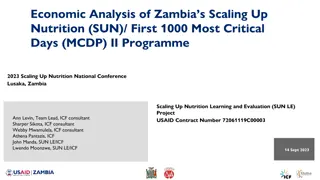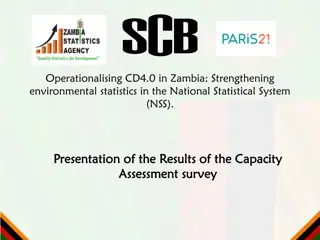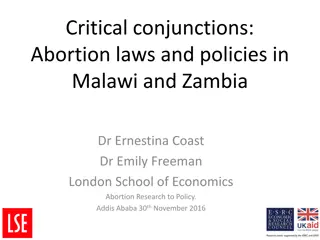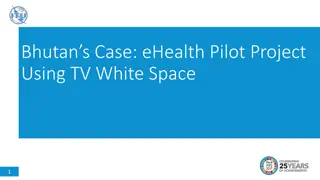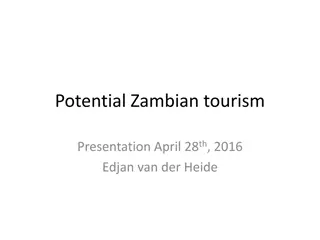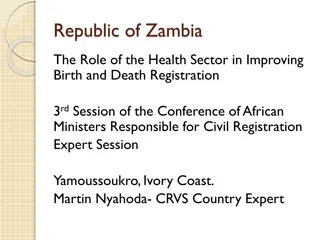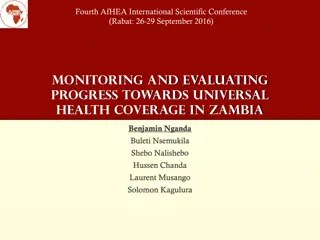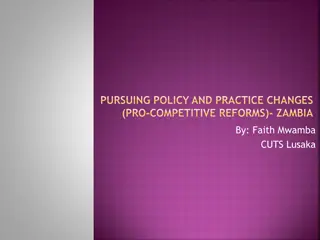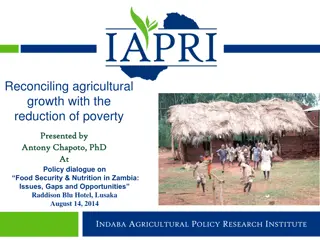Using Open-Source Optimization Tool for Last-Mile Distribution in Zambia
Explore the utilization of an open-source Dispatch Optimization Tool (DOT) for sustainable, flexible, and cost-effective last-mile distribution in Zambia. The tool aims to reduce costs, optimize delivery routes dynamically, and enhance efficiency in supply chain management. Learn about the benefits, experience of users, and the need for dynamic route optimization in the context of changing circumstances and uncertainties faced in distribution operations.
Download Presentation

Please find below an Image/Link to download the presentation.
The content on the website is provided AS IS for your information and personal use only. It may not be sold, licensed, or shared on other websites without obtaining consent from the author.If you encounter any issues during the download, it is possible that the publisher has removed the file from their server.
You are allowed to download the files provided on this website for personal or commercial use, subject to the condition that they are used lawfully. All files are the property of their respective owners.
The content on the website is provided AS IS for your information and personal use only. It may not be sold, licensed, or shared on other websites without obtaining consent from the author.
E N D
Presentation Transcript
Using an open-source Dispatch OptimizationTool for sustainable, flexible, and cost-effective last-mile distribution in Zambia June 26, 2024 Photo: Lan Andrian
Introductions Agenda Opening Remarks o Kevin Pilz (USAID) Experience Using the Dispatch Optimization Tool (DOT) in Zambia o Bruce Kamuti (ZAMMSA) Demo of DOT App and Other Use Cases o Eileen Patten (GHSC-PSM) Q&A Technical Demo: How to Get Started with GitHub Download and DOT Templates o Eileen Patten (GHSC-PSM) USAID GLOBAL HEALTH SUPPLY CHAIN PROGRAM-Procurement and Supply Management 2
ZAMMSA Experience Using DOT in Zambia Bruce Kamuti, ZAMMSA Innovation Reliability Efficiency Respect Integrity OUR USAID GLOBAL HEALTH SUPPLY CHAIN PROGRAM-Procurement and Supply Management VALUES Transparency 3 Teamwork Accountability Client Centeredness Environmentally Friendly
ZAMMSA Background: Why is a Dispatch Optimization Tool Needed? Innovation Reliability Efficiency Respect Integrity OUR USAID GLOBAL HEALTH SUPPLY CHAIN PROGRAM-Procurement and Supply Management VALUES Transparency 4 Teamwork Accountability Client Centeredness Environmentally Friendly
ZAMMSA What Problems Does the Dispatch Optimizer Solve? Reduce cost and time of deliveries while maintaining service standards by dynamically optimizing delivery routes. Innovation Reliability Efficiency Respect Integrity OUR USAID GLOBAL HEALTH SUPPLY CHAIN PROGRAM-Procurement and Supply Management VALUES Transparency 5 Teamwork Accountability Client Centeredness Environmentally Friendly
ZAMMSA Why Dynamic Route Optimization? Static Route Planning vs. Dynamic Route Optimization Software like the Dispatch Optimizer can allow rapid dynamic adjustments based on changing circumstances and uncertainty Can adjust to variability in orders (e.g., different commodity types, quantities, seasonal patterns) Can adjust to changes in vehicle and driver availability Can optimize late orders separately to find the most efficient dispatch plans while not delaying the on-time orders Can adjust as a rainy season impacts accessibility (e.g., split truck routes onto smaller 4x4 SUVs, remove inaccessible facilities) Open-source software and improving data and IT landscapes have opened options that used to be accessible primarily to corporations able to purchase costly software licenses. Using set routes planned with or without the use of route optimization software Even if routes are mathematically optimized, they are done so for one static scenario and reused under changing circumstances This makes it difficult to manage changing volumes, late orders, changing circumstances This is what most countries do today, but there is now the ability to do better. Innovation Reliability Efficiency Respect Integrity OUR USAID GLOBAL HEALTH SUPPLY CHAIN PROGRAM-Procurement and Supply Management VALUES Transparency 6 Teamwork Accountability Client Centeredness Environmentally Friendly
ZAMMSA Example: Why Relying on Static Routes is Problematic Loading Plans: Trucks Needed 8 total Volumes for the three routes shown in the chart on the right increased dramatically from the requisition in March 2023 to the one in May 2024. 20T*7 + 15T*1 7total 2023 2024 20T*6 + 10T*1 8 7 6 This increase occurred due to stock levels improving enabling ZAMMSA to fulfill more of the orders that are received from a 40-50% order fill rate up to 80% from 2023 to 2024. 5 2 total 20T 4 1 total 20T 3 1 total 20T 1 total 15T 2 1 The number of trucks required increased from just 3 to 17 and the total tonnage of trucks needed increased from just 55T to 325T 0 Lusaka 4 Lusaka 5 Lusaka 6 Innovation Reliability Efficiency Respect Integrity OUR USAID GLOBAL HEALTH SUPPLY CHAIN PROGRAM-Procurement and Supply Management VALUES Transparency 7 Teamwork Accountability Client Centeredness Environmentally Friendly
ZAMMSA A Successful Roll-out in Zambia Engagement with local stakeholders ZAMMSA collaborated with USAID s GHSC-PSM project and their 3PLs in Lusaka to coordinate efforts for the application and business processes User-focused design tailored to public health supply chains App developers spent time embedded in ZAMMSA central medical warehouse and 2 hubs, observing operations and collecting requirements for an operational route optimization application DOT being run in DOT being run in ZAMMSA Lusaka ZAMMSA Lusaka warehouse on warehouse on October 1, 2021 October 1, 2021 Ongoing and expanding operational use ZAMMSA staff use the tool weekly, with all regional hubs and about 2,135 last-mile health facilities in Zambia currently receiving deliveries planned using this tool; currently active in 4 hubs and working on expansion to every hub in the country First optimized First optimized dispatch leaving dispatch leaving Mansa hub on Mansa hub on June 3, 2022 June 3, 2022 Innovation Reliability Efficiency Respect Integrity OUR USAID GLOBAL HEALTH SUPPLY CHAIN PROGRAM-Procurement and Supply Management VALUES Transparency 8 Teamwork Accountability Client Centeredness Environmentally Friendly
ZAMMSA Transforming Transportation and Warehouse Planning AFTER BEFORE Data-driven decision making that is flexible to changing circumstances Reduced instances of multiple dispatches to the same facility Volumetrics and optimized vehicles ensure the best vehicles are planned for each load Transportation planners are well prepared to respond to changing or increasing order volumes, even during health crises Transportation planning was done manually, using guess work based on prior experience Sometimes delivered to the same facility on multiple routes for different commodities Warehouse sometimes staged orders and the truck was too small or unnecessarily large Consistently increasing commodity categories and volumes in Zambia was making reliance on prior experience risky Other benefits: Reduced costs and carbon emissions; increased customer satisfaction and employee/3PL coordination Innovation Reliability Efficiency Respect Integrity OUR USAID GLOBAL HEALTH SUPPLY CHAIN PROGRAM-Procurement and Supply Management VALUES Transparency 9 Teamwork Accountability Client Centeredness Environmentally Friendly
ZAMMSA DOT s Impact Beyond Transportation Planning DOT outputs are not just used by distribution planner but by all functions preparing for distribution in the warehouse Picking, Packing, Staging according to loading plan and schedule Wave Planner Plans Pick Waves based on dispatch order Load and Dispatch at 7 Dock Doors Distribution Planner Loading Plan Customer Service Informs Customers of Upcoming Deliveries and Gathers Feedback Shares with 3PL Manager Generates Purchase Orders (POs) and coordinates w 3PL providers Runs DOT & Produces Loading Plan Schedules trucks to arrive based on lead time needed to prepare orders and dock door availability Innovation Reliability Efficiency Respect Integrity OUR USAID GLOBAL HEALTH SUPPLY CHAIN PROGRAM-Procurement and Supply Management VALUES Transparency 10 Teamwork Accountability Client Centeredness Environmentally Friendly
Demo of Dispatch Optimization Tool App & Other Use Cases Eileen Patten, GHSC-PSM Photo: Lan Andrian
Collaborating with and Contributing to Open-Source Technology Tool built on top of open-source tools, as shown in the image to the left Deployed on Azure cloud and users access it like any website Source code is available for download on GitHub Tool can be adapted for other types of health commodity distribution or service delivery, such as for community health workers conducting home visits https://github.com/ghsc-psm/Dynamic-Optimization-Routing USAID GLOBAL HEALTH SUPPLY CHAIN PROGRAM-Procurement and Supply Management 12
How to Use the Dispatch Optimizer Tool USAID GLOBAL HEALTH SUPPLY CHAIN PROGRAM-Procurement and Supply Management 13
The Dispatch Optimizer Application Route maps, details and KPIs can be viewed on the interactive website Or downloaded in Excel for manual modifications, additional analysis, or sharing plans with warehouse staff and suppliers. USAID GLOBAL HEALTH SUPPLY CHAIN PROGRAM-Procurement and Supply Management 14
The footprint and features continue to grow, as other countries actively seek to learn from Zambia s example and adopt the tool. 2024 and Beyond October 2021 Early 2020 June 2022 July 2022 Zambia expanded to two new hubs this year and is planning three more by the end of 2025. New features are improving use. The Dispatch Optimizer was launched in Zambia s central medical warehouse in Lusaka. A proof of concept was developed by USAID GHSC-PSM in Excel and tested in Haiti. Based on the initial success, the tool was adapted and rolled out in Luanshya and Mansa, Zambia. The app was tested in Kenya, including developing new features to address country-specific needs. Mali conducted research with the tool and is looking towards implementation. 15 USAID GLOBAL HEALTH SUPPLY CHAIN PROGRAM-Procurement and Supply Management
How Can You Get Started With Dynamic Routing? Why: Greater flexibility, greater coordination, greater efficiency! Can also test impact of changes to fleet, distribution patterns, etc. Code and Templates for the Dispatch OptimizationTool are all available on the GHSC-PSM GitHub What You Need: List of facilities and their geocoordinates Details on fleet sizes and cost structures Distance matrix capturing distances and times between all facilities Order Details at the Facility Level We have a small amount of budget available for Technical Assistance if you want to get started or have questions about the Git repo reach out to Kevin Pilz and Eileen Patten During the section after the Q&A I ll walk you through the initial steps to download the app and review the templates required USAID GLOBAL HEALTH SUPPLY CHAIN PROGRAM-Procurement and Supply Management 16
Want to Learn More? Visit the QR Code on the Screen to Questions? Comments? Thoughts? USAID GLOBAL HEALTH SUPPLY CHAIN PROGRAM-Procurement and Supply Management 17
Technical Demo: How to Get Started with GitHub Download and DOT Templates Eileen Patten, GHSC-PSM Photo: Lan Andrian
